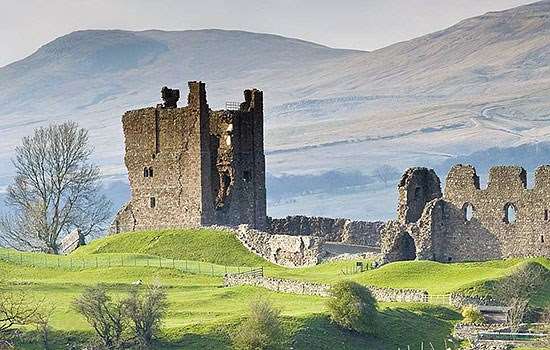Dartmouth’s First Castle
The lifeblood of Dartmouth was always the River Dart. Its long estuary, sheltered by a steep valley and with a narrow exit to the sea, was an ideal, safe port for sea-going trade. By the mid-12th century Dartmouth was a thriving place. Its wealth came from trade – particularly wine from Bordeaux and wool, wheat, minerals and other produce from south Devon and Dartmoor – and from fishing.
In 1336 tension between England and France turned into the open conflict that began the Hundred Years War. To guard against French invasion it was thought vital to defend the entrance to the Dart. In 1388 Richard II ordered the mayor of Dartmouth – the merchant and privateer John Hawley – to compel the townsmen to contribute to a ‘fortalice’, which was built shortly afterwards.
This small fort was Dartmouth’s first castle. It was only used in times of danger, so had few permanent buildings. A circular corner tower and adjoining length of stone wall survive.
Read more about John Hawley and PrivateeringThe Gun Tower
By the mid-15th century gunpowder was having more and more impact on warfare on land and at sea. England was still at war with the French. The English Channel was dangerous: fighting was common and ships of both sides were often captured. Almost a century after building the fortalice, the townsmen of Dartmouth considered strengthening the river defences with a new tower containing guns.
In 1462 Edward IV awarded them £30 annually for 20 years towards the cost of Dartmouth’s defences, including the laying of a massive iron chain across the River Dart to stop marauding ships getting through. But it was almost 20 years before work began on a new tower and a bulwark, or strongpoint, purpose-built for artillery. In 1486 Henry VII demanded completion of the gun tower ‘with all godly haste’.
The defences were eventually completed around 1493, and the gun tower became the heart of Dartmouth Castle. It contained the winding mechanism for the river chain, which was secured close to a defensive tower at Godmerock on the opposite bank.
Below: A reconstruction drawing showing Dartmouth Castle as it may have looked in about 1550. In the foreground, the iron chain across the estuary is being raised and tightened
© Historic England (illustration by Peter Urmston)
The 16th-Century Castle
By 1502 another gun tower and bulwark had been built on the opposite side of the river at Kingswear, and by about 1530 a gun fort occupied the river bank at Bayard’s Cove, right on the edge of Dartmouth town. This was intended as a last line of defence against enemy ships that had eluded Dartmouth and Kingswear castles and breached the river chain.
Although built by the town of Dartmouth, the castle was taken by force in 1552 by Sir Peter Carew, a powerful soldier and courtier whose family had owned the nearby manor of Stoke Fleming for centuries, and who claimed that the castle was built on his land. The town took him to court, but he probably held on to the castle until his death in 1575.
Sixteenth-century crises included the invasion scares of 1538–40, following Henry VIII’s divorce from Katherine of Aragon, and the threat of the Great Armada in 1588, when the Spanish warships sailed past Dartmouth on their way to meet the English fleet. An early casualty was the grand Spanish ship Nuestra Señora del Rosario, captured and brought into Dartmouth as a prize of war by Sir Francis Drake.
Read more about Peter Carew and the CastleCivil War Action
During the First Civil War (1642–6) between Charles I and Parliament, the prosperous town of Dartmouth was important to both sides, and changed hands twice.
On the outbreak of war the town repaired and manned its defences in support of Parliament. But In September 1643 a Royalist force under Prince Maurice, Count Palatine of the Rhine and Charles I’s nephew, attempted to capture the town. He met with determined resistance, and the Parliamentarians fought for another month before surrendering.
For two and a half years, although Parliamentarian warships maintained a blockade to stop supplies reaching the town by sea, Dartmouth remained in Royalist hands, and the king’s men built new forts high above the river. Then on 18 January 1646 Sir Thomas Fairfax’s Parliamentarian forces stormed the town at night, and the defenders were quickly overrun. With the town taken, the castle – isolated by the river – had no effective land defences, and surrendered after just two days.
Dartmouth under the government
After 1646 Dartmouth’s defences were usually controlled by the government, rather than the town. Two years after Charles II’s Restoration in 1660 Dartmouth had a new complement of the king’s ‘guard and garrisons’, comprising 23 men and a governor.
The castle and its guns were maintained at times of hostilities with the Dutch in the 1660s and 1670s and the French in the 1690s. But upkeep seems to have lapsed after that. In 1715 the military engineer Colonel Christian Lilly surveyed the defences of south-west England, and noted that Dartmouth Castle was in a ‘ruinous condition’, having ‘not one gun well mounted’. No more than 20 feet (6 metres) remained of its chain.
By 1741 most of the castle’s guns were mounted in Maiden Fort, an open battery of 12 guns on the site of the old bulwark, with a guardhouse for the gunners and their equipment. The battery was enlarged in 1747, probably in case of French invasion, when it was renamed the Grand Battery. This could house guns on two levels to control the approach to the harbour. From then on the medieval gun tower was mainly used for accommodation and storage.
The castle saw no action during the long war with Napoleonic France (1793–1815), when the guns were manned by volunteers of the Dartmouth Artillery.
The Victorian Gun Battery
After 1815 Dartmouth Castle had only a master gunner, who lived in the gun tower. Nonetheless, Dartmouth’s potential capture and use by an enemy to attack strategic Plymouth – where major work was done on the naval base defences in the 1850s – called for improvements to the castle. The War Office therefore rebuilt the Grand Battery as the two-tier Dartmouth Point Battery by February 1861.
At about this time, however, a Royal Commission on the Defence of the United Kingdom, appointed by Prime Minister Palmerston, reported on the impact of new technology on warfare. Hugely powerful guns with rifled barrels that greatly improved range and accuracy were being developed in parallel with the new steam-powered, ironclad warships. These innovations made coastal forts vulnerable to attack from the sea.
The Commission’s report prompted a national programme of fort building and equipping with large rifled guns. But Dartmouth Point Battery did not benefit, and so was almost immediately out of date.
The obsolete guns were finally replaced in 1891 by five heavy guns, which could fire shells weighing 64lb (29kg) up to 2¼ miles. Local volunteers were trained to use them against enemy warships.
Two of these guns survive at Dartmouth – one stands on the open gun platform of the battery and the other has been placed below. The film shows a modern re-enactment of the rooftop gun being fired.
Dartmouth in two world wars
In 1909 the War Office gave the gun tower and battery, now surplus to military requirements, to the Office of Works for display as a historic monument. Two years later, former gunner Sergeant Thomas Lawson became its first resident caretaker and guide.
The castle’s military role was not yet over, however. During the First World War two quick-firing guns were installed on Dartmouth Point Battery to prevent fast gunboats and torpedo boats from entering the harbour.
After 1918 the Office of Works restored the castle, and from 1922 leased it to the borough as a tourist attraction, with a tearoom in the battery. But when war came again in 1939, the harbour became a haven for merchant convoys and the Royal Navy commissioned Philips’ shipyard in Dartmouth to build boats and small ships.
So the castle entered its final military phase. Two quick-firing guns were installed to engage enemy ships up to 3 miles out to sea. Both guns were protected from air attack by concrete gun houses – one (now the ticket office) on Dartmouth Point Battery, the other (since dismantled) 170 metres south-west. Dartmouth Battery operated until 1943, when its role was taken over by Brownstone Battery on the cliffs east of the river mouth.
A short distance upstream, in an echo of the old river chain, the Royal Navy laid a floating barrier (a boom) across the river, with steel mesh nets hanging to the river bed, to prevent enemy ships and submarines entering the harbour.
After the war the Ministry of Works resumed responsibility for Dartmouth Castle, repairing it and leasing it to Dartmouth Corporation to open it to the public again.
Visit Dartmouth Castle


